Characterisation of Visible and Subvisible Particles
Overview
Discover how easily you can rapidly characterize particle concentration, size, and shape using the FlowCam® dynamic imaging particle analyzer.
The FlowCam collects an image, plus over 40 different parameters for each individual particle captured – all at the same speed of more traditional volumetric techniques. This system provides you an in-depth characterization of whole data populations, sub-populations, and even individual particles.
The FlowCam is a comprehensive particle analysis platform on its own. It also provides an efficient way to confirm data given by other particle analysis methods, and allows you to address the hard to answer questions that arise from sizing data alone.
Applications
- Food and Beverage
- Column Packing Material
- Abrasives
- Microencapsulation
- Washwater – Heterogeneous Sample Analysis
What the FlowCam does
- Measures particle size and shape and provides 40+ morphological measurements on each particle imaged.
- Provides superior image quality and image-based measurements – fast and accurate results you can see, backed by the quantitative data to prove it.
- Gives statistically relevant results quickly – allows user to look at tens of thousands of particles per minute.
- Allows automated, trainable, statistically-based pattern recognition – saves time by isolating different types of particles into categories and sub-populations.
- Delivers accurate results on all particles from 300nm to 5mm in size (count and morphology)
- Auto Focus feature provides convenient, repeatable focus.
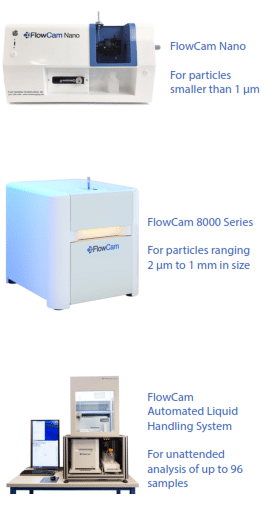
How the FlowCam works
The FlowCam imaging particle analysis system contains three core technologies: optics, electronics and fluidics.
The optical system is similar to a microscope, and is used to capture real-time images of the particles in the fluid as they pass through the flow cell. Additional optional electronics can also capture two channels of fluorescence information per particle.
The fluidics system uses an ultra-high-precision computer controlled syringe pump to pull the fluid sample through a flow cell perpendicular to the optical path.
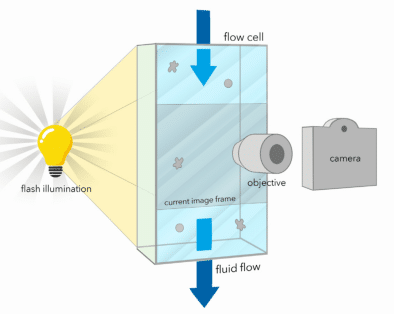
Turning data into insight: Visual Spreadsheet particle analysis software
VisualSpreadsheet is a powerful software program that allows you to interact with the particle images captured by the FlowCam. Improving on other particle analysis systems that only allow you to sort and filter rows of numeric data, VisualSpreadsheet gives you the ability to sort and filter actual images. Ultimately this provides a more in-depth analysis of your sample and a better understanding of your data.
Immediately find and display all similar-type particles in a heterogeneous sample with sophisticated pattern recognition capabilities. You can also create and save defined particle type libraries, then compare incoming FlowCam data against one or more libraries to instantly enumerate concentrations of specific particle types.

Food and Beverage
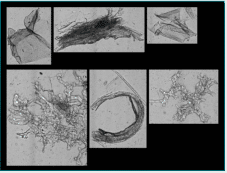
Column Packing Material
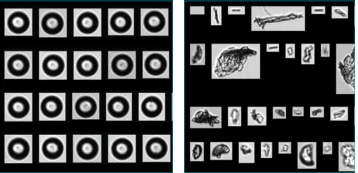
Abrasives
Superabrasives, such as micronized diamonds and cubic boron nitride (CBN), are used extensively in applications for cutting, grinding and drilling hard materials. The effectiveness of a particular superabrasive material in a given application is completely determined by both particle size and particle shape.
The FlowCam can characterize thousands of particles per minute – making it quick and easy to determine if a batch of superabrasives meets the desired specification. It would take hours to make the same characterization using manual microscopy, and results would not be the same statistical significance.
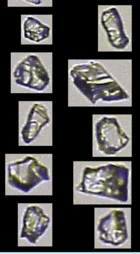
Microencapsulation
Microencapsulation is a commonly used technique in a wide range of applications – from pharmaceuticals to foods to detergents. The FlowCam imaging particle analyzer offers a unique insight into the microencapsulation process. When studying the effects of temperature, concentration, pH and other variables, the FlowCam can dynamically monitor capsule formation over time. This allows you to optimize the encapsulation process to yield the most clean coacervate formation.
By providing this insight into the process, the FlowCam can be an indispensable tool for microencapsulation R & D and QC applications.
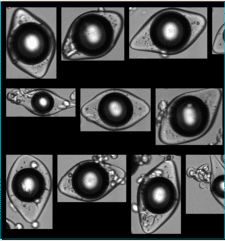
Wash water – heterogeneous sample analysis
In many applications, heterogeneous samples must be analyzed to characterize the types and quantities of particles present. In this example, water used to wash electronic devices after manufacturing is analyzed to determine particles present. Devices are washed to remove traces of fibers, metals and plastics that could remain from the manufacturing process, and it is important that the wash water contains less than a certain number of each of these particle types. Too many leftover particles could cause failures.
The FlowCam makes it easy to sort and filter particle data and build libraries that will automatically quantify and characterize each particle type.

